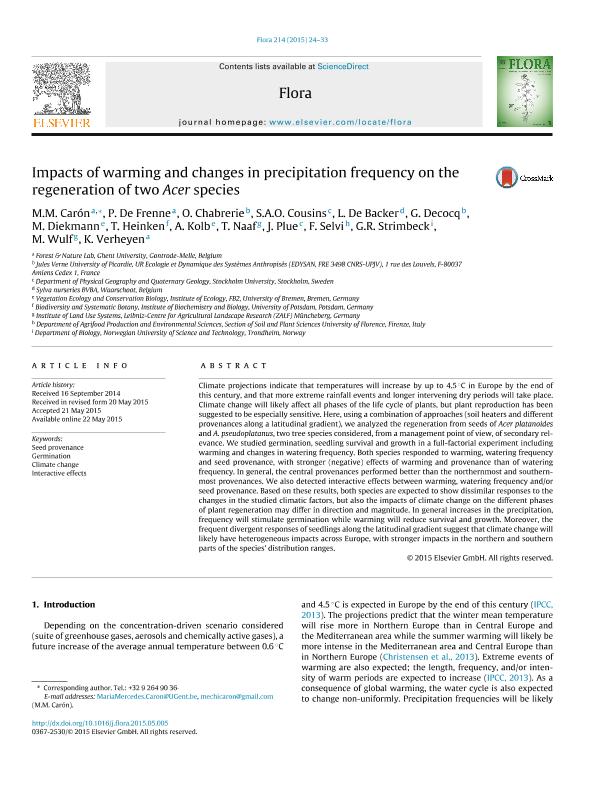Mostrar el registro sencillo del ítem
dc.contributor.author
Carón, María Mercedes

dc.contributor.author
de Frenne, P.
dc.contributor.author
Chabrerie, O.
dc.contributor.author
Cousins, S. O. A.
dc.contributor.author
De Backer, L.
dc.contributor.author
Decocq, G.
dc.contributor.author
Diekmann, M.
dc.contributor.author
Heinken, T.
dc.contributor.author
Kolb, A.
dc.contributor.author
Naaf, T.
dc.contributor.author
Plue, J.
dc.contributor.author
Selvi, F.
dc.contributor.author
Strimbeck, G. R.
dc.contributor.author
Wulf, M.
dc.contributor.author
Verheyen, K.
dc.date.available
2016-08-11T18:55:06Z
dc.date.issued
2015-05
dc.identifier.citation
Carón, María Mercedes; de Frenne, P.; Chabrerie, O.; Cousins, S. O. A.; De Backer, L.; et al.; Impacts of warming and changes in precipitation frequency on theregeneration of two Acer species; Elsevier Gmbh; Flora; 214; 5-2015; 24-33
dc.identifier.issn
0367-2530
dc.identifier.uri
http://hdl.handle.net/11336/7100
dc.description.abstract
Climate projections indicate that temperatures will increase by up to 4.5 °C in Europe by the end of this century, and that more extreme rainfall events and longer intervening dry periods will take place. Climate change will likely affect all phases of the life cycle of plants, but plant reproduction has been suggested to be especially sensitive. Here, using a combination of approaches (soil heaters and different provenances along a latitudinal gradient), we analyzed the regeneration from seeds of Acer platanoides and A. pseudoplatanus, two tree species considered, from a management point of view, of secondary relevance. We studied germination, seedling survival and growth in a full-factorial experiment including warming and changes in watering frequency. Both species responded to warming, watering frequency and seed provenance, with stronger (negative) effects of warming and provenance than of watering frequency. In general, the central provenances performed better than the northernmost and southernmost provenances. We also detected interactive effects between warming, watering frequency and/or seed provenance. Based on these results, both species are expected to show dissimilar responses to the changes in the studied climatic factors, but also the impacts of climate change on the different phases of plant regeneration may differ in direction and magnitude. In general increases in the precipitation, frequency will stimulate germination while warming will reduce survival and growth. Moreover, the frequent divergent responses of seedlings along the latitudinal gradient suggest that climate change will likely have heterogeneous impacts across Europe, with stronger impacts in the northern and southern parts of the species’ distribution ranges.
dc.format
application/pdf
dc.language.iso
eng
dc.publisher
Elsevier Gmbh

dc.rights
info:eu-repo/semantics/openAccess
dc.rights.uri
https://creativecommons.org/licenses/by-nc-nd/2.5/ar/
dc.subject
Seed Provenance
dc.subject
Germination
dc.subject
Climate Change
dc.subject
Interactive Effects
dc.subject.classification
Ecología

dc.subject.classification
Ciencias Biológicas

dc.subject.classification
CIENCIAS NATURALES Y EXACTAS

dc.title
Impacts of warming and changes in precipitation frequency on theregeneration of two Acer species
dc.type
info:eu-repo/semantics/article
dc.type
info:ar-repo/semantics/artículo
dc.type
info:eu-repo/semantics/publishedVersion
dc.date.updated
2016-08-11T13:58:50Z
dc.journal.volume
214
dc.journal.pagination
24-33
dc.journal.pais
Alemania

dc.journal.ciudad
Berlín
dc.description.fil
Fil: Carón, María Mercedes. University of Ghent; Bélgica. Consejo Nacional de Investigaciones Científicas y Técnicas. Centro Científico Tecnológico Salta; Argentina
dc.description.fil
Fil: de Frenne, P.. University of Ghent; Bélgica
dc.description.fil
Fil: Chabrerie, O.. Jules Verne University of Picardie. UR Ecologie et Dynamique des Systèmes Anthropisés; Francia
dc.description.fil
Fil: Cousins, S. O. A.. Stockholms Universitet; Suecia
dc.description.fil
Fil: De Backer, L.. Sylva nurseries BVBA; Bélgica
dc.description.fil
Fil: Decocq, G.. Jules Verne University of Picardie. UR Ecologie et Dynamique des Systèmes Anthropisés; Francia
dc.description.fil
Fil: Diekmann, M.. Universitat Bremen; Alemania
dc.description.fil
Fil: Heinken, T.. University of Potsdam. Institute of Biochemistry and Biology. Biodiversity and Systematic Botany; Alemania
dc.description.fil
Fil: Kolb, A.. Universitat Bremen; Alemania
dc.description.fil
Fil: Naaf, T.. Leibniz-Centre for Agricultural Landscape Research. Institute of Land Use Systems; Alemania
dc.description.fil
Fil: Plue, J.. Stockholms Universitet; Suecia
dc.description.fil
Fil: Selvi, F.. Universita Degli Studi Di Firenze; Italia
dc.description.fil
Fil: Strimbeck, G. R.. Norwegian University of Science and Technology. Department of Biology; Italia
dc.description.fil
Fil: Wulf, M.. Leibniz-Centre for Agricultural Landscape Research. Institute of Land Use Systems; Alemania
dc.description.fil
Fil: Verheyen, K.. University of Ghent; Bélgica
dc.journal.title
Flora

dc.relation.alternativeid
info:eu-repo/semantics/altIdentifier/url/http://www.sciencedirect.com/science/article/pii/S0367253015000456
dc.relation.alternativeid
info:eu-repo/semantics/altIdentifier/doi/http://dx.doi.org/10.1016/j.flora.2015.05.005
dc.relation.alternativeid
info:eu-repo/semantics/altIdentifier/doi/10.1016/j.flora.2015.05.005
Archivos asociados
